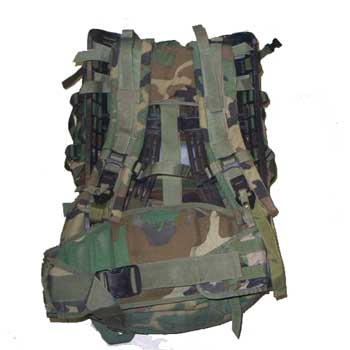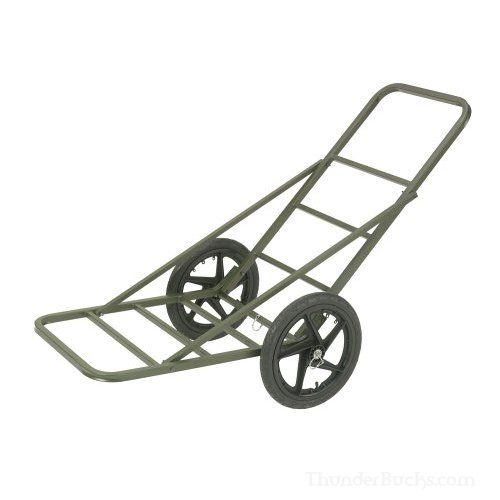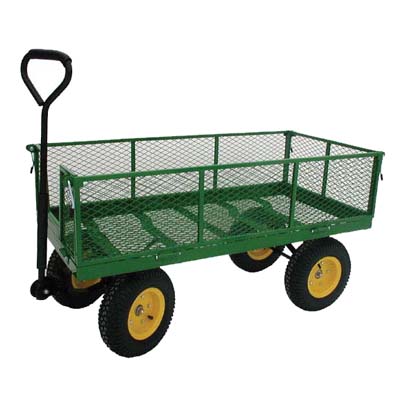#203295 - 06/11/10 09:57 PM
 Re: Weight
[Re: ireckon]
Re: Weight
[Re: ireckon]
|

Pooh-Bah
Registered: 09/01/07
Posts: 2432
|
Assuming your in shape and acclimated to the conditions the rule of thumb I'm familiar with was that one-tenth your body weight could be carried with little slowing but increased fatigue. For maximum mobility you want to keep the encumbrance under this level.
(US infantry is often at this level with little more than body armor and boots.)
one-quarter of your body weight is as heavy as you can go and maintain any ability to run. Even a jog for a short time.
One-third of your body weight is as heavy as you can go and walk fast.
One-half your body weight is as heavy as you can go if you want move faster than a crawl.
Note that these expected speeds are over a considerable distance/ time and most everyone can muster up the strength for short bursts of speed.
|
|
Top
|
|
|
|
#203298 - 06/11/10 10:24 PM
 Re: Weight
[Re: ireckon]
Re: Weight
[Re: ireckon]
|

Member
Registered: 06/06/10
Posts: 102
Loc: Canada
|
One of the things I learned was to weigh stuff.
I am not a gram weenie, but the grams do add up to kilograms and 5 kilos can make the difference between a reasonable hike or a miserable and exhausting slog.
If you take all the trinkets and put them in a bag and weigh them all together you are likely in for a rude surprise.
Small items that weigh nothing tend to add up fast and suddenly you find yourself with 10 lbs of small tools, and usually they all copy each other's functions.
Packaging matters too. I have seen people with half their pack full of the packaging their stuff came in.
That stuff all weighs.
Check how much all the holsters and pouches on stuff weigh and be sure you need them. Often you can get better protection by stowing some gear inside other gear.
For example: My GPS unit is usually either in my pocket or in the pack.When in the pack it needs some protection.
I keep it in my spare socks instead of the special pouch (which stays home).
Another thing to weigh is the pack itself.
You need a certain amount of material to make a strong stable pack. After that every extra bit of pocket, zipper or strap is adding extra weight so you want to be sure they help.
I have two expedition packs here that are the same size but one is twice as heavy as the other. The heavy one is designed to stand up to the abuse of rock climbing.
I always suggest people load their pack and walk about one mile out and back, then get the scales out and start looking.
If you are doing it in a city be sure to include some hills and stairs.
|
|
Top
|
|
|
|
#203300 - 06/11/10 11:35 PM
 Re: Weight
[Re: JBMat]
Re: Weight
[Re: JBMat]
|

Carpal Tunnel

Registered: 08/03/07
Posts: 3078
|
Any ideas or things that you do to cut weight. Get the titanium version (half the weight of the steel version), get the down version (half the weight and half the packable volume of the synthetic version, hence smaller and lighter backpack) and get the most reliable highest performance kit (not necessarily the lightest) you can afford for the weather and terrain conditions that you can expect so you don't need a backup or a backup to a backup. The quality of the backpack and its ability to move with the hiker whilst keeping the load stable and the load bearing ability on the hips is also important. Most UL packs are lacking in this respect. The extra 1 or 2 lbs in additional weight for the pack might be very worthwhile for long term comfort. The cooking and sleeping systems need particular attention. For example a gas cartridge cooking system will be lighter and higher performance than an alcohol stove if the time out in the wilds is greater than 2-3 days. For shelter a lightweight tent might also be the way to go when compared to a tarp or basha/ground sheet/bivi bag combo as the differences in weight could be very slight especially when considering the weather performance difference. Much will be dictated by the terrain and the weather conditions. http://www.youtube.com/watch?v=73KKZDhoj_0And sometimes you need a really good tent to cope on a blustery rainy day.  http://www.youtube.com/watch?v=r4NN3cltuuY http://www.youtube.com/watch?v=r4NN3cltuuY
|
|
Top
|
|
|
|
#203303 - 06/12/10 01:19 AM
 Re: Weight
[Re: Am_Fear_Liath_Mor]
Re: Weight
[Re: Am_Fear_Liath_Mor]
|

Geezer in Chief
Geezer
Registered: 08/26/06
Posts: 7705
Loc: southern Cal
|
The aluminum version is also half the weight of the steel version and is considerably cheaper.
_________________________
Geezer in Chief
|
|
Top
|
|
|
|
#203305 - 06/12/10 02:18 AM
 Re: Weight
[Re: hikermor]
Re: Weight
[Re: hikermor]
|

Pooh-Bah
Registered: 09/01/07
Posts: 2432
|
The aluminum version is also half the weight of the steel version and is considerably cheaper. Yes, replacing a steel version of a piece of gear with aluminum, or titanium can save half the weight. Finding out you can do without that piece of gear can save you all of the weight.
|
|
Top
|
|
|
|
#203308 - 06/12/10 03:43 AM
 Re: Weight
[Re: Art_in_FL]
Re: Weight
[Re: Art_in_FL]
|

Old Hand

Registered: 01/28/10
Posts: 1174
Loc: MN, Land O' Lakes & Rivers ...
|
I'll admit that I struggle with the whole 'bug-out' concept. My first instinct would be to 'shelter in place', the second would be to 'shelter with a nearby relative', and a distant third, 'to walk out'. I'm well covered with the first two, but I have made provisions for the third, even though my plans for that scenario are nebulous at best. When planning to travel overland, I leave the equipment matters to the experts; the US military. I don't need to reinvent the wheel, or spend a fortune. I go the the surplus store and get what I need. I have PSKs, trunk kits, containerized camping gear, daypacks, FAKs, portable food and water stored in my vehicles, garage, my provisions area, and a rented off-site storage area. By purchasing some used military rucks, cargo bags ($15), and duffles ($5), I can put together any size BoB very quickly. With the gigantic Molle II external frame backpack ($10), I can carry 70 pounds on my back if I have to, and there is a smaller pack for my (smaller) wife. I also obtained a collapsible game cart rated at 300 pounds, and a garden wagon with removable sides. I can strap the Molle II pack to the cart, or lighten it to carry and strap a lot of other gear and provisions to the cart or wagon. I doubt I would ever resort to walking out, but most of the gear required is multi-use.
Attachments
   
_________________________
The man got the powr but the byrd got the wyng
|
|
Top
|
|
|
|
#203316 - 06/12/10 06:49 AM
 Re: Weight
[Re: JBMat]
Re: Weight
[Re: JBMat]
|

Stranger
Registered: 06/10/10
Posts: 4
Loc: Connecticut, U.S.A
|
Make a copy of your packing list. Pack in reverse order, priority items packed last, like you normally would. When you do this, you'll catch yourself tossing the stuff you really don't need, but want, in the bottom of the bag. Scratch off whatever you don't actually use when you get home from each trip. Also, look at places that teach or give guided mountaineering/backpacking trips. A lot of them have detailed required gear lists online. More often than not, if you don't see it in their list, you probably don't need it.
Consider replacing some of those under layers with silk, get a few silk ski masks that you can fold/roll up off your face to use as a hat. A few pairs of silk gloves. That sheds a lot of weight and bulk, though all relative to the trip lengths. Do you have a scale that reads grams? Weigh your matchbox against a Bic lighter. I'd rather have the lighter than the matches.
Talk yourself into things like "everything MUST be flat packable", and, "everything MUST have multiple uses". Almost impossible...still, those two will kick your creativity into gear. I winter trek a lot, and cutting weight is always on my mind - but only if it's practical, with my well-being at the top of the list first. I don't consider myself an ultra-lighter, because if I'm goin' campin', I plan on eatin'... a lot.
If there's no fire restrictions where you hike,cook all your meals over open fire. Making (or buying) a .016" thick stainless steel backpacking stove that burns wood instead of an alcohol stove or regular backpacking stove for your back-up cuts some liquid weight off. Or you could do the Esbit thing.
I have a frameless pack with a hydration pouch, for 2-4 day non-winter treks. I keep my cooking grate and my sleeping pad in the pouch. Now I have a sturdy frame and padding. If you go that way, make sure it all fits before you buy. Some pouches are tight and that might cause bulging into your back. If you use a self inflating closed-cell like I do, just experiment with the valve to try different back support levels.
The shelter system is based on what you can afford, and prefs. Out under the stars in a bivy/tarp system? Or a tent? My 4 lb two person tent has been good enough, but middle age is creeping up on me. I am considering weighing up a set of custom carbon fiber poles against the dac aluminum ones to see if there's significant difference in weight. It can get pricey. I've also been eye-balling the Go-Lite Shangri-La 1 in case I want to drop a little more weight in the future. The tent body, which is really just a fly, weighs 1 lb.,plus 3 ounces for 6 stakes and the optional floored nest is 15 ounces. Go-Lite didn't list that as the packed weight, and I would assume it also comes with a stuff sack, but who knows. There's no included poles because it's pitched using 2 trekking poles or by hanging it with 2 lines. If you don't use trekking poles, you can custom make poles, or use some sticks you find laying around.
Thinking about how you plan, prepare, and cook your meals can change things enough to where you may decide that the fry pan can be kicked to the curb also. Unless it doubles as your lid and/or plate. I just stew or fry in my pot, eat from my pot. Aside from oatmeal, all the other food types are grilled or kabob.
Pre-cooking certain foods can have it's advantages, like removing excess water weight, grease, it lowers the chance of spoilage, and you just have to re-heat instead of a full cook time. If you like dehydrated foods and snacks, you can save a lot of money on camp food if you buy a home dehydrator and do it yourself. Personally, I dislike those pre-packaged dehydrated foods, because they taste like crap, cost too much money per portion, have less nutrition, and force people to carry more water. That same water weight can be fat juicy steak. You can control how much re-hydrating you need with a home kit. Overall, you'll eat better, have more fun, and can pump the savings into better gear.
_________________________
I might not know where I'm going, but I'll recognize it when I get there
|
|
Top
|
|
|
|
#203317 - 06/12/10 08:08 AM
 Re: Weight
[Re: SETI6equj5]
Re: Weight
[Re: SETI6equj5]
|

Veteran
Registered: 09/01/05
Posts: 1474
|
I hike about every other day for exercise and walk the dog daily for at least a mile. Even without a pack, it can be a PITA. Especially if my knees decide to stay home that day or another old injury rears its head. You guys may be in a much better position to BO on foot. For me, thats the absolute least desirable scenario. Hence the bike and cart suggestions. Recently got back into bike riding after a long hiatus and its amazing how much more distance you can cover with casual biking than you can walking. I'll take a sore butt over sore knees anyday. Come to think of it, a modified moped/50cc scooter might also be an option.
|
|
Top
|
|
|
|
|
|
|
1
|
2
|
3
|
4
|
5
|
6
|
|
7
|
8
|
9
|
10
|
11
|
12
|
13
|
|
14
|
15
|
16
|
17
|
18
|
19
|
20
|
|
21
|
22
|
23
|
24
|
25
|
26
|
27
|
|
28
|
29
|
30
|
31
|
|
|
|
|
|
1 registered (chaosmagnet),
938
Guests and
64
Spiders online. |
|
Key:
Admin,
Global Mod,
Mod
|
|
|